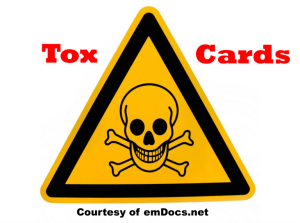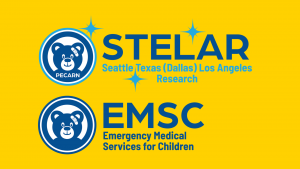Authors: Ryan Sumpter, MD (Uniformed Services University, Bethesda, MD), Rachel Bridwell, MD (@rebridwell, EM Resident Physician, San Antonio, TX) // Reviewed by: Brit Long, MD (@long_brit, EM Attending Physician, San Antonio, TX); Alex Koyfman, MD (@EMHighAK, EM Attending Physician, UTSW / Parkland Memorial Hospital)
Welcome to EM@3AM, an emDOCs series designed to foster your working knowledge by providing an expedited review of clinical basics. We’ll keep it short, while you keep that EM brain sharp.
A 40-year-old male is brought in by EMS after being struck on his left side while crossing the street by a vehicle at 20 mph. He is visibly uncomfortable, laying on his right side, and refusing to move his left leg.
Exam reveals BP 130/80, HR 104, RR 18, T 98.6 F temporal, SaO2 98% on room air. His left lower extremity has an obvious effusion along with localized swelling and tenderness over the lateral aspect of his knee joint. Ligament and meniscal evaluation cannot be completed due to pain on knee exam. There are no signs of neurovascular compromise on exam.
What’s the likely diagnosis, and what are the next steps in your evaluation and treatment?
Answer: Tibial Plateau Fracture1-13
Epidemiology:1
- Incidence of tibial plateau fractures is 10.3 per 100,000 people annually.
- Bimodal distribution: Men < 50 years old more likely to sustain injury via high energy mechanisms; Women > 70 years old more likely to sustain secondary to falls.
- Account for 1% of all fractures and are typically sustained with high-energy mechanisms.
- Mean age of patients incurring tibial plateau fractures is 52.6 years.
Clinical Presentation:
- Patients typically present in discomfort, refusing to bear weight on the affected extremity.
- May have effusion, open soft tissue injury, ligament injury, and neurovascular deficits present.
- Location: unicondylar vs. bicondylar.2
-
- Frequency: lateral > bicondylar > medial
-
- Tibial Plateau fractures commonly classified based on Schatzker Classification System:3
- Higher grades typically require more aggressive intervention.
- Frequencies: 35.1% (II), 20.1% (VI), 15.9% (V), 11.7% (IV), 8.8% (III), 8.4% (1).4
- Schatzker I: Lateral split fracture, from axial load with valgus stress.
- Schatzker II: Lateral split-depressed fracture, most common tibial plateau fracture
- Schatzker III: Lateral pure depression fracture, rare and seen only in older patients with severe osteopenia.
- Schatzker IV: Medial condyle fracture, from axial or varus stress, usually high-energy.
- Schatzker V: Bicondylar plateau fracture, from pure axial force on extended knee, high-energy injury.
- Schatzker VI: Metaphyseal-diaphyseal dissociation, results from combination of high-energy forces, depression and impaction of fragments.

Evaluation:5
- Assess ABC’s and vital signs.
- Nature of tibial plateau fractures often secondary to high-energy trauma and patients may have multi-system trauma. Do not ignore high energy polytrauma to include unstable pelvis, flail chest, etc. when distracted by painful and deformed lower extremity.
- Thorough knee exam, including:6
- Inspection, palpation, varus/valgus stress testing, and complete neurovascular exam.
- Evaluate dorsalis pedis and posterior tibial pulses bilaterally
- Low threshold to use doppler
- Assess tibial and peroneal nerves by testing plantar flexion and dorsiflexion, sensation along posterior calf/plantar foot and lateral calf/dorsal foot.
- Evaluate for any surface wounds suggestive of open fracture.
- Frequently re-evaluate for progression of symptoms of compartment syndrome which would require urgent intervention.
- Patients are at significant risk for compartment syndrome.
- Evaluate dorsalis pedis and posterior tibial pulses bilaterally
- Examine ipsilateral hip and ankle for any injuries, especially in high-energy mechanisms.
- Imaging:
- Radiographs:
- Recommend obtaining AP, Lateral, and Oblique views (oblique is helpful to determine amount of depression).
- However, sensitivity for fracture detection only 85% even with 4 views.7
- AP view findings: depressed articular surface, sclerotic band of bone indicating compression fracture, and abnormal joint alignment.
- Lateral view findings: evaluate for posteromedial fracture lines.
- Optional plateau view (10 degree caudal tilt)
- CT:7
- Sensitivity and Specificity for detecting fracture site, displacement, and bony fragments range from 92.9-98.8% and 50-98.5%, respectively.8
- Important to identify articular depression and comminution
- Findings: lipohemarthrosis, indicating occult fracture, and fracture fragment orientation to assist in surgical planning.
- CT Angiogram may identify vascular injuries, more commonly seen in Schatzker type IV fracture-dislocations.
- MRI:9,10
- Lower utility in ED, no well-established indications, but can be useful to determine meniscal and ligamentous pathology.
- Up to 36% of patients with tibial plateau fracture can have an unstable meniscal tear, along with 55% having injury in tibial collateral ligament and 34% having injury in fibular collateral ligament.
- Often the choice for follow up after radiographs given ability to demonstrate associated ligamentous or meniscal injury.
- Radiographs:
- Complications:
- Fibular Fracture
- Often accompanies tibial plateau fractures.
- Fibular head fractures can be associated with tibial plateau fractures in up to 30% of cases.11
- Open fractures: merit immediate surgical consultation.
- ACL Injury: more common in type IV and VI Schatzker fractures.
- Acute Compartment Syndrome:
- Clinical signs include tense swelling of lower leg, decreased distal pulses, muscle weakness, increased pain by passive dorsiflexion, and impaired sensation.
- Risk of Acute Compartment Syndrome in tibial plateau fractures approximates 11%.12
- Factors associated with development of Acute Compartment Syndrome include Schatzker VI fractures, fibular fractures, fracture length, and plateau-shaft combined injury.13
- Fibular Fracture
- Inspection, palpation, varus/valgus stress testing, and complete neurovascular exam.
Treatment:2
- Compression, ice, analgesia, splinting of the knee in near-full extension, intermittent elevation of the leg above heart level, and strict non-weight bearing.
- Splinting in the ED: bulky jones with a knee immobilizer
- With larger displacement, long leg L&U may be necessary
- Nonoperative fractures may be placed in a hinged knee brace with permissive weight bearing for 8-12 weeks and immediate passive ROM.
- Non-displaced split or depressed fractures, low energy fracture stable to varus/valgus alignment, and non-ambulatory patients.
- All other fractures, particularly those from a high energy mechanism, consult Orthopedic Surgery for operative management.
- Includes any degree of displacement or depression, meniscal or ligamentous injury, neurovascular compromise, and ACS.
- Update tetanus if indicated and antibiotics for open fracture.
Disposition: Consult orthopedics.
- Lower-energy fractures may be surgically managed on an ambulatory basis, while others require immediate surgical management.
- Immediate surgical management: severely depressed fractures, Compartment syndrome, neurovascular compromise, and open fractures.
- Minimally displaced fractures may be managed surgically on an ambulatory basis if patients are educated thoroughly on non-weight bearing until orthopedic management.
Pearls:
- High clinical suspicion of acute compartment syndrome in high energy mechanisms, Schatzker VI fractures, and associated fibular fractures requiring frequent compartment checks.
- At minimum, 4 radiographic views of affected knee are recommended. CT can assist.
- With the exception of non-displaced or non-depressed fracture without meniscal or ligamentous injury, expect to be calling orthopedics with a well-done exam for surgery.
- Keep compartment syndrome at the forefront of your thoughts during initial assessment and reevaluations.

A 46-year-old man presents with knee pain after being tackled while playing rugby. He is unable to bear weight due to pain. On examination, he has a moderate joint effusion. Range of motion is limited due to pain and effusion but there does not seem to be any joint laxity. Plain X-rays do not reveal a fracture but a lipohemarthrosis is noted. What is the best next step in management?
A) Ace wrap to knee and discharge with outpatient orthopedic follow-up
B) Admit for surgical repair
C) Arthrocentesis
D) CT of the knee and orthopedic consultation
Answer: D
Integrity of the tibial plateau, comprised of the medial and lateral condyles of the proximal tibia, is essential for normal stability and motion of the knee. Tibial plateau fractures most often occur in the setting of high-energy injuries as a result of a valgus or varus force on the knee with or without axial loading. Associated injuries, such as meniscal tears or ACL injuries, are frequently seen. Tibial plateau fractures can also be seen in older adults with osteoporotic bones in the setting of low-energy mechanisms. Patients present with knee pain, soft tissue swelling, and pain with weightbearing. Evaluation of ligamentous injuries is difficult in the acute setting due to pain and effusion. A full neurovascular exam is essential, as injury to the popliteal artery, anterior tibial artery, and peroneal nerve is possible. Knee radiographs may show depression of the tibial plateau, widening of the joint space, or avulsion fractures. Finding of a lipohemarthrosis, a fat-fluid level on plain film, is concerning for an occult fracture. Orthopedic surgery should be consulted and a CT of the knee ordered for further evaluation. Definitive treatment depends on the severity of the injury, with stable nondisplaced fractures treated with immobilization. Surgical management is required for unstable fractures.

Given the finding of a lipohemarthrosis on plain film, discharge with an Ace wrap and outpatient follow-up (A) is inappropriate. While these patients can potentially be further evaluated in the outpatient setting, they should be immobilized and made non-weightbearing, and orthopedic surgery should be contacted prior to discharge to ensure timely follow-up. Not all tibial plateau fractures require admission for surgical fixation (B). The first step in this case should be further evaluation with CT for definitive diagnosis. An arthrocentesis (C) is more commonly performed to evaluate a possible septic joint. It is not necessary to drain a moderately sized hemarthrosis.
OSF
What is a Segond fracture?
An avulsion fracture from the lateral tibial plateau at the site of the attachment of the lateral capsular ligament.
References:
Pallin DJ. Knee and lower leg. In: Walls RM, Hockberger RS, Gausche-Hill M, et al., eds. Rosen’s Emergency Medicine: Concepts and Clinical Practice. 9th ed. Elsevier; 2018:(Ch) 50.
https://www.clinicalkey.com/#!/content/book/3-s2.0-B9780323354790000507
Further Reading:
Recommended FOAM:
- https://coreem.net/core/tibial-plateau-fractures/
- https://emergencymedicinecases.com/tag/tibial-plateau-fracture/
- https://litfl.com/schatzker-classification-of-tibial-plateau-fractures/
- https://www.aliem.com/splinter-tibial-plateau-fractures-leg-1/
- https://www.orthobullets.com/trauma/1044/tibial-plateau-fractures?expandLeftMenu=true
References:
- Elsoe R, Larsen P, Nielsen N et al. Population-Based Epidemiology of Tibial Plateau Fractures. Orthopedics. 2015;38(9):780-6. doi:10.3928/01477447-20150902-55
- Tibial Plateau Fractures – Trauma – Orthobullets. https://www.orthobullets.com/trauma/1044/tibial-plateau-fractures. Accessed April 19 2020.
- Zeltser D, Leopold S. Classification in brief: Schatzker classification of tibial plateau fractures. Clinical Orthopaedics and Related Research. 2013. doi:10.1007/s11999-012-2451-z
- Albuquerque R, el Hara R, Prado J, et al. Epidemiological study on tibial plateau fractures at a level I trauma center. Acta Ortopedica Brasileira. 2013. doi:10.1590/S1413-78522013000200008
- Saloni M, Rosenberg N. Tibial Plateau Fractures. StatPearls Publishing. 2020.
- Tibial Plateau Fractures – SpintER Series – AliEM. https://www.aliem.com/splinter-tibial-plateau-fractures-leg-1/. Accessed April 20, 2020.
- S Gray, P Kaplan, R Dussault et al. Acute knee trauma: How many plain film views are necessary for the initial examination? Skeletal Radiology. 1997. doi:10.1007/s002560050239
- Elalfy A, Bessar M. Which Imaging Modalities are Needed for Successful Treatment of Different Grades of Tibial Condylar Fractures? American Research Journal of Radiology and Nuclear Medicine. 1(1): 1-12.
- Colletti P, Greenberg H, Terk M. MR findings in patients with acute tibial plateau fractures. Computerized Medical Imaging and Graphics. 1996. doi:10.1016/S0895-6111(96)00054-7
- Mustonen AO, Koivikko MP, Lindahl J, et al. MRI of acute meniscal injury associated with tibial plateau fractures: prevalence, type, and location. American Journal of Roentgenology. 2008. doi:10.2214/AJR.07.3811
- Zheng Z, Yu Y, Chang H, et al. Establishment of Classification of Tibial Plateau Fracture Associated with Proximal Fibular Fracture. Orthopaedic Surgery. 2019. doi:1111/os.12424
- Ziran B, Becher S. Radiographic predictors of compartment syndrome in tibial plateau fractures. Journal of Orthopaedic Trauma. 2013. doi:10.1097/BOT.0b013e31828e25b6
- Marchand L, Working Z, Rane A, et al. Compartment Syndrome in Tibial Plateau Fractures. Journal of Orthopaedic Trauma. 2019. doi:11097/bot.0000000000001703









1 thought on “EM@3AM: Tibial Plateau Fracture”
Pingback: ePulse: Highlights of the week 2 – 8 May 2020 – V E N T R I C L E